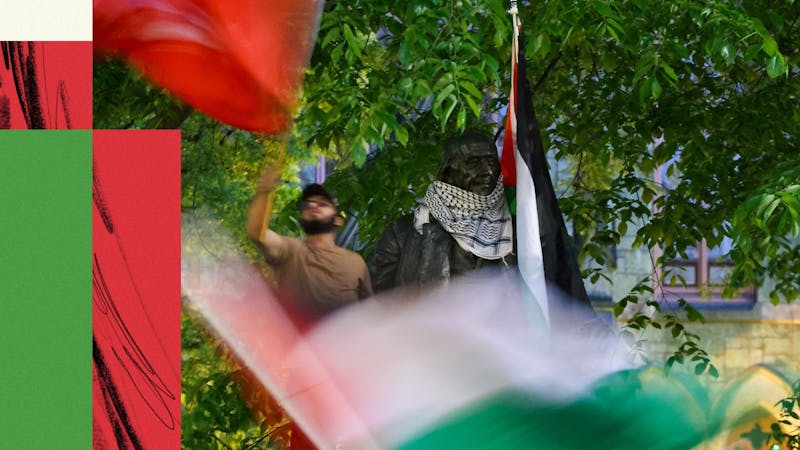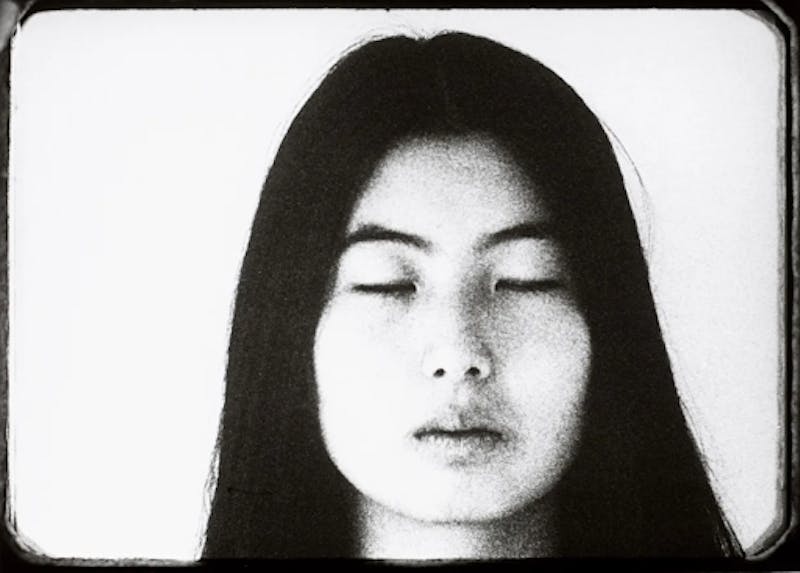There’s a good chance you’ve already violated the Temporary Standards and Procedures for Campus Events and Demonstrations this semester. You violated section five, clause A when you played “Von dutch” on your WONDERBOOM as you walked across Locust Walk to that 11:30 p.m. pregame; section three, clauses D, E, and G when your consulting club held an initiation event after–dark at The Button without registering with University Life Space and Events Management; section six, clause A, point two when you used spray chalk, instead of sticks, to advertise your a cappella show in front of the high rises.
Like most students, however, you weren’t made aware that you were violating University rules—albeit temporary ones. At most, you received a stern warning from the omnipresent cop car parked by the steel enclosures of College Green—hell, you probably didn’t know there were temporary standards in the first place.
The Temporary Standards and Procedures for Campus Events and Demonstrations were first sprung upon the Penn community on June 6, in an email with a subject line of the same name from the Interim Penn President Larry Jameson.
“Today, we write to share two important updates about Penn’s policies and procedures for when, where, and how open expression can take place,” writes Jameson. “First, effective immediately, Penn will adopt and implement Temporary Standards and Procedures for Campus Events and Demonstrations. [...] Second, a faculty–led Task Force will be charged with reviewing the Guidelines on Open Expression and making recommendations for revisions to the Guidelines.”
The magnitude of this announcement, and the changes it planned to implement, were likely lost on students, parents, and faculty alike who were more concerned with summer plans than the academic year.
At first glance, these standards appear no different than the standing Guidelines on Open Expression themselves—after all, they share a similar jumble of Roman numerals and buzzwords. But where they diverge, the temporary standards’ deviation is anything but slight.
The standards read as a frantic boarding up of holes, with administrators eager to fill in the “gaps” of the official guidelines. Chalk and building–side light projections may not be the concern of the GOE, but the temporary standards are quick to ensure these modes of expression will not slip through a second time. And, most notably, while the original GOE explicitly stated that the content of one’s speech cannot be restricted by the University, the temporary standards are happy to do just that.
The temporary standards’ relationship to the original and existing GOE is left open for interpretation, merely stating that they are “sourced from numerous existing policies and guidelines.”
Who, exactly, wrote these guidelines is also up to question. Andrew Vaughan, assistant professor for biomedical sciences at the School of Veterinary Medicine and member of the American Association of University Professors–Penn and the Faculty Senate, can at least rule out the Faculty Senate from the list of contributors.
“When they sent out that email with the interim guidelines, it said it was in consultation with the Faculty Senate, which is a stretching of the truth at best. They sent us this vague draft of it,” says Vaughan. “Me and the other two members of this subcommittee made a bunch of edits [and] sent that back to the tri–chairs of the Faculty Senate. They sent it back to the Provost’s office, and then that was the last we heard of it. And then we were just as surprised as anybody else to see the interim guidelines come out.”
Despite its central role of providing guidance to the administration on matters relating to the guidelines, the Committee on Open Expression, tasked with monitoring and recommending improvements to University communications, was not responsible for these temporary standards, either. Lisa Bellini, chair of the Committee on Open Expression and recently appointed executive vice dean for the Perelman School of Medicine, affirms this. “The committee was not involved in the development of the temporary standards.”
While the true intent behind adopting the temporary standards may be information only Jameson himself is privy to, students have speculated that they were, in part, created to retroactively justify the suspension of the students. What seems more plausible, however—given that the students were already in violation of the GOE—is that the new standards aim to justify future disciplinary action against student protestors.
The Guidelines on Open Expression were not a part of Ben Franklin’s great vision for Pennsylvania’s educational center. Just as the temporary guidelines have been tacked onto the school handbook to curb student activity, the GOE was only created in an effort to curtail the Vietnam–era protests at the University.
Following the first antiwar protests against Dow Chemicals—the producer of napalm, a chemical used on the battlefield by the United States—Penn established the Mundheim Commission in November 1967 to interrogate speech on campus. The report that the commission produced included recommendations such as planning demonstrations to avoid interrupting the activity of others, creating a committee of students and faculty to interpret and make decisions on the guidelines, and leaving the use of University facilities to the discretion of the administration. Ultimately, it would serve as the blueprint for the GOE created nearly two years later.
The original Guidelines on Open Expression were officially adopted in April 1969 by the University Council. In its juvenile form, the GOE outlined the standards for assembling and demonstrating, and established the Committee on Open Expression, composed of five students, five faculty, and two members of administration. It held a vague purpose of interpreting the guidelines and making judgements on violations. The limitations implemented by the 1969 GOE appear brief in comparison to the grueling pages of the temporary standards, simply stating that demonstrators could not act in a way that would injure person or property, or interfere with the activities of others.
As the antiwar movement intensified, it came time for the GOE to stand the test of practice. Protests of the early ‘70s strained against the passivity encouraged in the previous years’ decision prompting the Committee on Open Expression, still in its infancy, to have the guidelines reprinted in The Daily Pennsylvanian. It was a “gentle” reminder of the standards under which they were expected to act.
The tug–of–war between the University administration and the presence of the national antiwar movement within the student body would snap in October 1972, when 12 Penn students and faculty members would face trial; not in court of law, but in “University Court.” Seven hours of testimony and deliberation, 200 community members present as eager spectators, and law school faculty members serving as representatives for the defendants—all to determine whether the individuals acted in violation of the GOE during their occupation of College Hall, and what were to be the repercussions of their actions. Although the charges were dropped on the grounds of insufficient evidence, the gravity of the newly adopted standards, and the looming threat of their enforcers, became evident with the spectacle’s close.
This wasn’t the last instance of the GOE and the Committee on Open Expression’s limits being tested. In the following two decades, numerous moments of tension prompted the campus to ask the collective question: Are the Guidelines on Open Expression working?
In 1991, then–president Sheldon Hackney at last heard the University community’s resounding opposition, adopted an altered set of guidelines which marks the final publicized amending of the guidelines as of today. While the changes were largely cosmetic—tweaking of titles, and wording here and there—the most notable, and controversial, change was the declaration that when two University policies conflict, the GOE takes precedence.
The Fossil Free Penn protests during the fall of 2022 brought a novel challenge to the issue of policing student activities. Following a protest staged during the Aug. 29, 2022 convocation ceremony, two students received emails a couple of weeks later, informing them that disciplinary proceedings for their involvement would begin promptly.
The emails, sent by The Center for Community Standards and Accountability, stated that the center “alleges that you interfered unreasonably with the activities of others, namely participants in the 2022 Penn Convocation on College Green.” One of the two target students, Ari Bortman, reported to the DP that he believed his continuous involvement in Penn’s activist communities played a part in him getting reported, while the approximately 100 other students in the convocation protest were not.
FFP’s members continued to find themselves targeted by these avenues regulating campus expression. Notably, their 39–day encampment on College Green was deemed in violation of University policy, according to a University spokesperson who spoke to the DP. While the encampment remained on College Green, participants faced constant surveillance by administrators, both openly and covertly, keen to determine any violations of the GOE. Executive Director of the Office of Student Affairs Katie Bonner attended a press conference on Sept. 27, 2022 for the purpose of ensuring the group didn’t exceed the 85 decibels of projected sound detailed in the guidelines.
The overseers of the guidelines found their disciplinary golden ticket on the Homecoming football game against Yale on Oct. 22, 2022, when over 60 students stormed the field, resulting in the arrest of 19. In a statement to the DP, a Penn spokesperson said on the topic of the guidelines, “The intentional disruption of today’s football game was neither an appropriate expression of free speech, nor consistent with Penn’s open expression guidelines.” While the specific point of violation was not cited, it seems likely that the groups were found in violation on the grounds of unreasonable interference with the activities of others, a common blanket clause of the guidelines cited to implicate protestors.
As the GOE has been adapted to the issues of each era, its application has varied significantly, ranging from ambiguous at best to outright harmful at worst. And yet, it was not until the Gaza Solidarity Encampment—a demonstration no different in tactic than the decades of predecessors—occurred that the looming threat of permanent changes to the GOE occurred.
Controversy has consistently clouded the effectiveness of the guidelines. Calls for amendments roll in, and roll out, as the tide of campus speech changes. One running point of contention is whose responsibility it is to determine the guidelines and whether guidelines were violated.
As shown by the guidelines’ fraught history, updating does not always signify that the changes in GOE will be more equitable. The current standards are several dozen pages longer than those first implemented in 1969, but their shared system continues to subdue student protestors with a looming threat of disciplinary action, and further drown out demands in the confusion of commissions, committees, working groups, and task forces. The bureaucratic red tape of the current system does not seem to be lost to administrators.
“One of the things that we're really hoping to be able to clarify with any proposed revisions are the relationships between these different groups [...] and make it very clear to the community who's doing what and who's responsible for what, because I think that's been a source of significant confusion,” says Bellini.
“We have a stake in this as well. This is our University. We are representing the faculty, that's our job, so shouldn't we have a role in how this situation is being dealt with? It felt as though President Jameson was not particularly interested in that,” says Vaughan. “There needs to be transparency about who's placed on that committee, how the Committee on Open Expression is assembled.”
According to Bellini, the task force is primarily faculty led, but does include staff members and two students, one graduate and undergraduate, as well. She is leading the effort alongside task force Co–chair and Graduate School of Education professor Sigal Ben–Porath, who declined to comment on her involvement in the process.
The quick fix provided by the temporary standards may be a sign of more lasting changes to come. “There is a process that's been put in place by the President and the Provost to bring a [task force] together [...] Our first meeting is [in August], when we will start to work on potential revisions to the Open Expression Guidelines,” said Bellini, co–chair of the new task force, this summer. With over 30 years having passed since the last change to the GOE, the 2024–25 academic year may finally usher in updated guidelines to catch up to evolving campus speech culture.
In a statement to Street, a Penn spokesperson said the following when asked about the temporary standards: “All members of the Penn community are expected to review the Temporary Standards and Procedures for Campus Events and Demonstrations. Disrupting University operations is not permitted, and members of the Penn community who violate any of the policies or guidance within the Temporary Standards will be subject to the applicable University disciplinary procedures.”
As causes have cycled through Locust, the GOE has been refined to further restrict the activities of demonstrators and, in turn, prevent the advocacy from extending beyond the label of “public disturbance.” Whether the campus is looking forward to a speech playbook that more closely matches the stringent Temporary Standards, or is another promise of institutional change to go unfulfilled, remains to be seen.
A metal sign was erected just a few weeks shy of new students’ arrival onto campus, reiterating this new ban on encampments and limits on the speech which may occur on College Green. It blends seamlessly in with the others that decorate the lawns of the school. No smoking, no bikes—no overnight protest.





